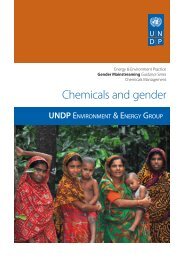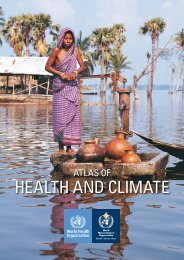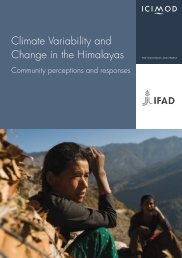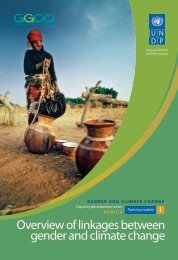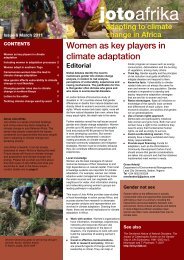Module 4: Gender, Agriculture and Food Security - Gender Climate
Module 4: Gender, Agriculture and Food Security - Gender Climate
Module 4: Gender, Agriculture and Food Security - Gender Climate
- No tags were found...
Create successful ePaper yourself
Turn your PDF publications into a flip-book with our unique Google optimized e-Paper software.
8. Women participate in food production activities such as hoeing, weeding,<br />
harvesting, l<strong>and</strong> preparation, threshing, transportation <strong>and</strong> usage. They also<br />
broadly support agricultural development through soil <strong>and</strong> water conservation,<br />
afforestation <strong>and</strong> crop domestication. However, the asymmetries in ownership<br />
of <strong>and</strong> access to vital livelihood assets (such as l<strong>and</strong>, water, energy, credit,<br />
knowledge <strong>and</strong> labour) constrain women’s contributions to food production<br />
(World Bank 2009; FAO 2011b). For example, men’s l<strong>and</strong> holdings are almost<br />
three times that of women’s l<strong>and</strong> holdings. In certain cases, the asymmetries<br />
are even more acute. For example, women are 5 percent of registered<br />
l<strong>and</strong>holders in Kenya. Limitations on such essential assets often lead to lower<br />
yields for women than would otherwise be possible if household resources<br />
were allocated equitably (World Bank 2009; FAO 2011b). This also leads to<br />
women having a lower adaptive capacity (UNDP HDR 2007).<br />
9. As with food production, women play a key role in food distribution (access).<br />
At the household level, once a family collects its harvest, women must<br />
distribute <strong>and</strong> allocate the food stock until the next harvest. Women often<br />
manage the production of subsistence crops, increasing food availability for<br />
the household. Related to this, rural women tend to spend more of the income<br />
they make from food crops (compared to men) on food, health, clothing<br />
<strong>and</strong> education for their children, hence improving the entire household’s<br />
food security (World Bank 2009; FAO 2011b). However, women still face<br />
difficulties related to food distribution. In many African states, distribution<br />
of food to local markets, especially for food crops, as opposed to cash crops,<br />
entails arduous head-loading by women. Some studies note that women<br />
transport 26 metric-ton kilometres per year compared to less than 7 metricton<br />
kilometres for men (World Bank 2009). A related obstacle for women in<br />
rural areas is time poverty, that is, the ability of people to engage in other<br />
productive activities (such as education) that is constrained by time spent on<br />
subsistence chores. Firewood <strong>and</strong> water collection is largely done by women<br />
<strong>and</strong> girls on foot. <strong>Climate</strong>-induced scarcity of natural resources can diminish<br />
food security by further constraining the time available to women. Water<br />
degradation <strong>and</strong> pollution can force women to travel farther to collect water<br />
<strong>and</strong> reduce the amount they collect.<br />
See <strong>Module</strong> No. 5<br />
12<br />
<strong>Gender</strong> <strong>and</strong> <strong>Climate</strong> Change Capacity development series Afric a<br />
Training module 4 <strong>Gender</strong>, agriculture <strong>and</strong> food security




